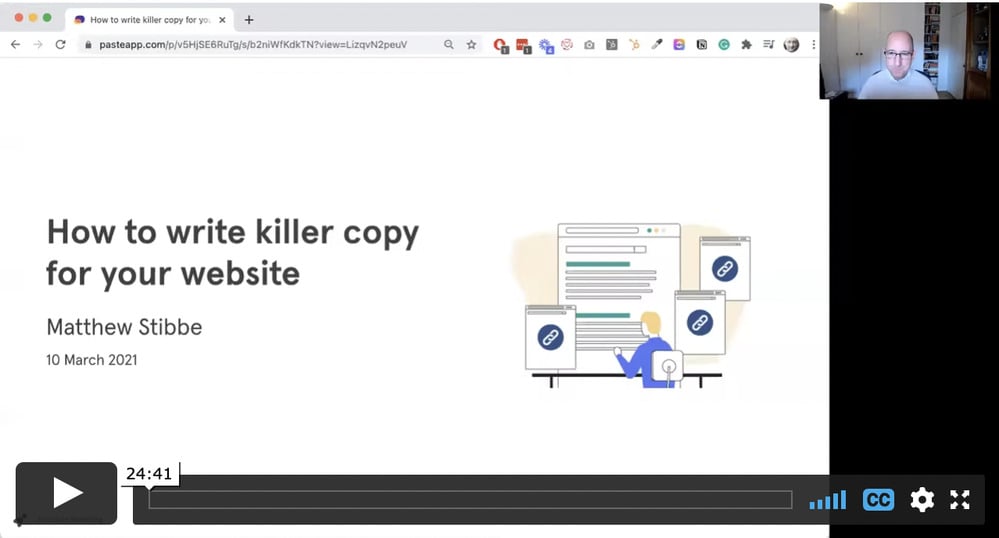Are you looking to improve your website copy?
Well, you're in the right place. Today, we’re going to share some of our web copywriting wisdom. If we’re honest, this is probably both the hardest and the most rewarding writing that we do.
Specifically, we’re going to look at the ‘seven rules for killer copy’. We’ll run through each of the rules alongside some examples of good and bad copy.
Watch the video
This blog was originally a webinar, which you can view here:
 Download slides from the webinar
Download slides from the webinar
The science of good web copy
When it comes to writing for the web, the first thing to appreciate is that you cannot change how people read online. Or, indeed, how people read altogether.
Just like physics or biology, there is a reality to how people read that we have to work with.
For most people, reading entails one continuous motion from left to right and from top to bottom. Obviously, it’s different in some other languages, but for English, this is how it is.
However, the reality is that your eyes don’t move smoothly. Instead, they are jumping from one place to the next. A bit like a child on hot sand on a beach. Below is a picture that shows this.
-1.jpg?width=885&name=screenshot-pasteapp.com-2021.04.06-14_35_34%20(1)-1.jpg) When it comes to reading web pages, you also have the F-shaped pattern as a result of the eyes jumping up and down and from left to right. You can see this in the heat map below.
When it comes to reading web pages, you also have the F-shaped pattern as a result of the eyes jumping up and down and from left to right. You can see this in the heat map below.
-1-1.jpg?width=673&name=screenshot-pasteapp.com-2021.04.06-14_34_55%20(1)-1-1.jpg) The hot red areas are where people’s eyes spend the most time. The eyes skip to the first paragraph, then to a subheading, then to bullet lists, then to statistics, etc. It’s always in this F-shaped pattern.
The hot red areas are where people’s eyes spend the most time. The eyes skip to the first paragraph, then to a subheading, then to bullet lists, then to statistics, etc. It’s always in this F-shaped pattern.
This image shows that people don’t read conventionally on a webpage. They might read an article once they’ve consciously decided to read it. But, for most pages, the eyes jump around. That’s because we’ve trained ourselves to jump to the information we’re looking for.
Crucially, this means people make a fast decision about whether a webpage has the information they want. This happens in just a few seconds.
The Nielsen Norman group identified this 15 years ago. And, it’s still true to this day. Very few people read every word on every web page. It was 16 percent in 1997. Today, it’s probably a lot less.
The Nielsen Norman group also did a test around the effect of words and writing on the usability of text online. They did a series of experiments where they had a long piece of text and they tried to make it more concise, more ‘scannable’ and with more bullet points. They also removed marketing hype words.
As a result, the copy was objectively twice as usable, memorable, impactful and credible as the original text. Studies like these inform the best-practices for writing for the web.
So, bearing these studies in mind, let’s unpack the seven rules for killer web copy.
The seven rules are:
- Concise
- Scannable
- Objective
- Human
- Emotive
- Dangerous
- Witty
Rule #1 Concise
The first rule of Fight Club is... Whoops, sorry – wrong list.
The first rule of writing killer copy is to be concise.
To make this a reality, use the following:
- Short words, short sentences and short paragraphs. So, ‘use’, not ‘utilise’. Etc.
- Fewer punctuation and acronym 'speed bumps'. These force the reader to slow down. They have to think and work harder. With less punctuation, your work is more scannable.
- Plain language. Don’t use language that’s complex, too industry-specific or hard to understand.
- Avoid the passive voice. Using the passive voice makes it harder for people to process text. So, instead of: ‘the mat was sat on by the cat’, say: ‘the cat sat on the mat’.
- Use Hemmingway app and Grammarly. These are great tools for simplifying your copy and removing the passive voice. Don’t follow them slavishly, but do use them.
Following these rules will also help with SEO. Why? Because Google has a readability check. We think it runs this on all pages of the internet. It uses that to help decide whether content is expert, authoritative and trustworthy.
Here’s a good example of an about us page from the Nielsen Norman group.
-1-1-1-1.jpg?width=725&name=screenshot-pasteapp.com-2021.04.06-14_43_33%20(1)-1-1-1-1.jpg) It’s great because it uses concise, well-structured content. There’s also a hierarchy of information in short sentences and paragraphs.
It’s great because it uses concise, well-structured content. There’s also a hierarchy of information in short sentences and paragraphs.
Rule #2 Scannable
As we learnt from looking at heat maps, readers scan web pages for what they want.
So, it makes sense to make your pages scannable.
To do this you’ll need to use:
- Clear, noticeable (and big) headings and subheadings.
- Front-loaded information in an inverted pyramid.
- Bulleted lists to break up text.
- Bold text to highlight key information.
If you’re a journalist, you’ll be familiar with the inverted pyramid. For those new to the idea, it means putting information in the most concise format at the start of the article. Then, as you go through the article, you unpack progressively more detail.

It’s like when you pick up a newspaper. You should be able to read the headline or first paragraph, and get the gist. Then, every subsequent paragraph adds more detail.
Here’s a great example from Apple:
-1.jpg?width=699&name=screenshot-pasteapp.com-2021.04.06-14_47_07%20(1)-1.jpg)
They’ve used a super-title, they’ve got a subheading, a body text and a nice call to action (CTA). It looks good to us!
Rule #3 Objective
As you know, we’re marketers. Naturally, that means we’re in favour of our clients and not completely objective. That’s not the same as ‘shilling’ for them though.
So, we try to do a few things to be as objective as possible. These include:
- Write for your reader, not your boss. The client wants to talk about a bunch of stuff. But you’re writing for the people who are going to read the copy. You work for them.
- Truthiness: facts, links, data. This will make your work feel more validated and authentic. In turn, you’ll be more objective and persuasive.
- Avoid hype words. If you use hype words, you’ll undermine the trust the reader has in you. Hype words are words like ‘best of breed’ and ‘end-to-end solution’. Don’t use them.
- Don’t weasel. By this we mean cutting out words like ‘could, should and maybe’. These words deflate your statements like a balloon. Don’t use them. Be confident and assertive instead.
Below is an example of what to avoid. It’s HP using hype words like ‘Premium Envy family’ - this doesn't really mean much. Also, they use ‘killer audio’ which is another hype word. Yes, we’ve called our web copy lessons 'killer’, so we’re throwing stones in a glass house. But, hey - no one's perfect.
-1.jpg?width=801&name=screenshot-pasteapp.com-2021.04.06-14_48_06%20(1)-1.jpg)
Rule #4 Human
You’ll also want to make your copy more ‘human’ so that readers feel like you’re having a conversation with them.
Below is an example of copy we wrote for our friends at Ripple Intranet and Phillip Schofield there. (No, not that Phillip Schofield, another one).
-1.jpg?width=744&name=screenshot-pasteapp.com-2021.04.06-14_49_31%20(1)-1.jpg)
We love writing for them because they give us permission to write something with a bit of flair, and they say things like, ‘just set every dial to 11.’ And that’s lovely.
The human tone we’ve used in this example makes it sound more like a conversation. ‘Why you’ll love us’ is a great example of that.
The best copy tends to be more 'human' like this. There’s more humanity, more: ‘I’m a real person; you’re a real person, so let’s have a conversation'. This makes it more compelling and engaging for the reader.
Rule #5 Emotive
As we’re in B2B technology, things tend to be very logical and informative. Lots of facts.
That doesn’t mean you can‘t use emotive words though. Crucially, if you do, you’ll add more resonance and depth to your work. So, use words like ‘indulge’ or ‘delight’ to make your writing sing.
It’s also a great idea to get the senses involved. If you can, talk about what you would hear, see, smell, feel. This adds more emotional resonance. For example, Apple talk about the comfort of using their keyboards.
Taking into account your audience persona is another part of writing emotively. Are you writing for a teacher? A doctor? A lecturer at a university? Each will have a different emotional register. This means you’ll need to write to appeal to the emotions of that audience.
Rule #6 Dangerous
Good web copy is dangerous. It’s got a bit of, ‘Oh my God - don’t say that!’
Obviously, there’s a line. But you don’t want to write something that’s safe. Safe copy is copy that your boss approves of. Safe copy is the kind of writing that’s approved of in the office.
We sometimes call this the ‘man in the mirror’ problem. This is where our clients want us to write copy that speaks to them. And, as our clients are deeply technical people, they want to see technical copy. But, if their audience is a non-technical business audience, it shouldn’t be technical.
Our clients say, ‘That’s not something I would write!’ And they’re correct. But it’s not for them. It’s for their audience.
Here’s a bad example from Cognizant’s New Signature website.
-Aug-15-2022-12-36-32-68-PM-1.jpg?width=621&name=screenshot-pasteapp.com-2021.04.06-14_51_33%20(1)-Aug-15-2022-12-36-32-68-PM-1.jpg)
It doesn’t contrast so well with the Nielsen Norman Group page we looked at.
There are monolithic blocks of text, hype words, inside baseball language etc. There’s just a lot of stuff that needs cutting back. It’s also far too safe.
Rule #7 Wit
The final rule for good copy is that it should be witty. We don’t necessarily mean jokey. Jokes can be tricky, but wit is achievable. Witty writing is great because it adds nuance and layers of meaning to copy. It also helps to enrich your copy.
As an example, to add wit to our website, we added our own ISO standard to the footer. Lots of our clients have ISO standards, so we thought we’d need one too. It's a nice little Easter egg.
Cultural references work well when it comes to adding wit, too. On our website, we’ve got ‘Nothing is too complicated. Except love and time machines’. It works to add a bit of charm, and it’s a nod to culture.
.png?width=540&name=screenshot-pasteapp.com-2021.04.06-14_52_45%20(1).png)
Great copy is just one part of great marketing
So, could your website copy do with a spruce?
From keeping things more objective to adding a bit of wit, we’ve covered some sure-fire ways to add life to your web copy.
But, there’s more to great marketing than writing great copy...
So, if you’d like to hold a mirror up to your marketing to see what’s working, you can download our marketing maturity matrix now.






-1.jpg?width=885&name=screenshot-pasteapp.com-2021.04.06-14_35_34%20(1)-1.jpg) When it comes to reading web pages, you also have the F-shaped pattern as a result of the eyes jumping up and down and from left to right. You can see this in the heat map below.
When it comes to reading web pages, you also have the F-shaped pattern as a result of the eyes jumping up and down and from left to right. You can see this in the heat map below.-1-1.jpg?width=673&name=screenshot-pasteapp.com-2021.04.06-14_34_55%20(1)-1-1.jpg) The hot red areas are where people’s eyes spend the most time. The eyes skip to the first paragraph, then to a subheading, then to bullet lists, then to statistics, etc. It’s always in this F-shaped pattern.
The hot red areas are where people’s eyes spend the most time. The eyes skip to the first paragraph, then to a subheading, then to bullet lists, then to statistics, etc. It’s always in this F-shaped pattern.-1-1-1-1.jpg?width=725&name=screenshot-pasteapp.com-2021.04.06-14_43_33%20(1)-1-1-1-1.jpg) It’s great because it uses concise, well-structured content. There’s also a hierarchy of information in short sentences and paragraphs.
It’s great because it uses concise, well-structured content. There’s also a hierarchy of information in short sentences and paragraphs.
-1.jpg?width=699&name=screenshot-pasteapp.com-2021.04.06-14_47_07%20(1)-1.jpg)
-1.jpg?width=801&name=screenshot-pasteapp.com-2021.04.06-14_48_06%20(1)-1.jpg)
-1.jpg?width=744&name=screenshot-pasteapp.com-2021.04.06-14_49_31%20(1)-1.jpg)
-Aug-15-2022-12-36-32-68-PM-1.jpg?width=621&name=screenshot-pasteapp.com-2021.04.06-14_51_33%20(1)-Aug-15-2022-12-36-32-68-PM-1.jpg)
.png?width=540&name=screenshot-pasteapp.com-2021.04.06-14_52_45%20(1).png)
